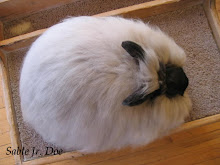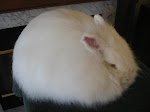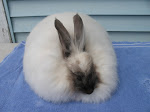Okay, continuing with heritability of traits, here is a chart that actually breaks down each individual component of an Angora coat to determine the heritability of each separate characteristic (I realize this is a little in-depth for even the most neurotic among us, LOL, but it's definitely interesting information:)). This chart is also taken from the 'Rabbit Production' book on pg. 334 (8th Edition):
Trait--- % Heritability
Wool Yield: 1st and 2nd harvest 0.20-0.23
1st thru 5th harvest 0.19-0.33
3rd or later harvest 0.23
Wool Characteristics:
Back bristle length 0.25
Back down length 0.16
Back lock structure 0.17
Compression 0.19
Haunch bristle length 0.25
Haunch down length 0.15
Homogeneity 0.18
Resilience 0.18
Tautness 0.09
Basically the point here and what the authors seem to be trying to say is that Wool is fairly changeable and subject to improvement by selection. On pg. 335 of the same book it says, "Since heritability is moderate, genetic progress for wool traits will largely be determined by how rigorously the breeder selects. This will in turn depend, in part, on the size of the herd. If the herd consists, for example, of only 2 bucks and 10 does, the breeder cannot practice intense selection because there will not be many offspring from which to select, despite the high degree of genetic influence for wool traits."
In other parts of this book and according to info. I have read from other sources, serious linebreeding cannot occur in herds that consist of fewer than 50 animals. While it is not necessary to have hundreds of rabbits (and not practical in our case with the maintenance needs of an Angora), a decent-sized gene pool is still important to create in order to preserve vigor and variation in your herd. Lots of breeders I know have smaller herds and simply buy stock in from other rabbitries every once in awhile, but I have a closed herd here so I have enlarged my herd to approx. 60 FAs in order to keep going without bringing in new stock.
Another interesting point according to many long term breeders is that it is far easier to improve and set Wool than it is to fix Type. I am finding that wool faults in many of my own rabbits fix themselves in 1-2 generations if I breed each doe to a mate that compliments their shortcomings, but Type is much more difficult to set, and it is a long, slow process of building and improving one section at a time. When I breed to work out a type problem, I find that I need to put alot more thought into what I am doing and who I am breeding in order to improve a certain trait because they do not fix themselves overnight:(.
More stuff next time and have a great week!:-)
Saturday, September 27, 2008
Subscribe to:
Post Comments (Atom)























No comments:
Post a Comment